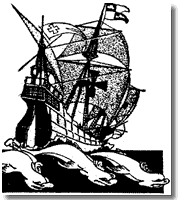|
 History History
There is long history about the islands, starting on the year 1835, the most famous of all visitors to the Galapagos, Charles Darwin, arrived aboard the HMS Beagle, commanded by Captain Robert FitzRoy.
The Beagle spent just five weeks in the archipelago during which time the 26-year old Naturalist was able to visit four of the principal islands - Chatham, Charles, Albermarle and James - where he spent 19 days on land, collecting and observing the flora and fauna of this 'living laboratory of evolution", a term often used to describe the islands.
What he meant by this was that the isolation, confined habitats and the comparatively small number of species combine to give the observer a clear view of the adaptive processes - called "adaptive radiation". The most famous example is the Galapagos finch, now called Darwin's Finches. Each were of the same population yet they were distinctive by the beak structure that was purposeful and adaptive.
Darwin's genius was in understanding that the variations he observed were non-random positive adaptations to the environment that could somehow be passed on through inheritance. Fifty years later, he published his work, Origin of Species by Means of Natural Selection, expounding his theory of evolution - a scientific revolution contradicting religious beliefs, a very strong controversy nowdays.
|

 History
History